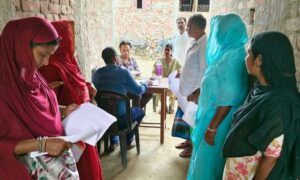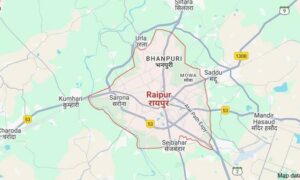
India is preparing for a countrywide rollout of the human papillomavirus vaccine, marking an important step towards reducing cervical cancer-related morbidity and mortality.
In April, the health ministry began training frontline workers following the interim budget announcement in February 2024 that the government would encourage vaccination against HPV for girls between the ages of nine to 14.
But limiting the vaccine to women and girls does not address the larger public health burden posed by HPV, a virus that affects people of all genders, not just women.
Apart from cervical cancer, HPV is implicated in other cancers – vulvar, vaginal, penile, anal, and oropharyngeal – and genital warts.
According to an American study conducted in 2019, nearly 85% of women and 91% of men with at least one sexual partner of the opposite sex are estimated to contract HPV during their lifetime. Research further indicates that men are more likely than women to carry high-risk HPV strains.
Globally, HPV-associated cancers are a substantial burden across genders. Apart from penile cancer, which affects men, anal cancer affects all genders with around 50,000 new cases and 19,000 deaths estimated worldwide in 2020.
Evidence from a 2012 US study indicates that anal cancer incidence rates are higher among men who have sex with men, especially those living with HIV – the human immunodeficiency virus.
In India, a study found a high incidence of HPV-associated cancers among men, who account for a significant portion of non-cervical cases: for 2025, the study projected nearly 25,000 cases of HPV-associated cancers among men and nearly a lakh among women.
Another study in two Indian cities of 300 HIV-positive men who have sex with men found a 95% prevalence of anal HPV infection among the men. Given the prevalence of HPV across all sexually active populations, vaccination must be inclusive of all genders to tackle HPV-related cancers.
Feminisation of HPV
The focus on vaccinating women is justified, given the disproportionate cervical cancer burden. But this framing perpetuates gender stereotypes and risks “feminising HPV” as a women’s issue, reinforcing the idea women are solely responsible for sexual and reproductive health.
It can also limit secondary prevention efforts, such as screening and treatment, to women while excluding men, preventing them from being aware of their own risks. The absence of HPV screening for men adds to this narrative.
The combined effect is that the diagnostic and treatment burden is placed primarily on women while men’s role in transmission and prevention is sidelined.
Moreover, restricting vaccination ends up further marginalising populations like men who have sex with men, transgender communities, and gender-diverse persons who are already vulnerable to systemic discrimination in healthcare.
HPV vaccines in the private sector are also out of reach for most Indians. Cervavac, India’s indigenous vaccine, costs about Rs 2,000 per dose, while Gardasil-9 is priced as high as Rs 11,000 per dose.
Recognising this cost barrier, the National Technical Advisory Group on Immunisation had recommended the inclusion of the HPV vaccine in India’s universal immunisation programme as early as 2022. In August, a parliamentary panel said the recommendation should be expedited “to reduce cervical cancer incidence and improve women’s health outcomes”.
Over 75K women die due to cervical cancer in India annually. It’s preventable thru HPV vaccine which costs 10K rupees! Thats unaffordable for most women & girls. Issued notice to Centre seeking
introduction of HPV vaccine in Universal Immunization Programme for adolescent girls. pic.twitter.com/SAT75d25fx— Swati Maliwal (@SwatiJaiHind) August 16, 2023
What can India do
The challenges in India’s HPV vaccination programme can be addressed by a nuanced, rights-based, evidence-informed and gender-inclusive perspective.
First, school-based HPV vaccination programmes – already under way in Sikkim and Bihar – should be expanded to include all adolescents, regardless of gender. This would normalise vaccination as core preventive healthcare. As national efforts move from pilot to phased rollouts, subsequent drives should focus on vaccinating children of all genders, closing the current gap in protection.
Second, India needs large-scale, India-focused studies on men to build robust, country-specific evidence and challenge persistent misconceptions that HPV is not a male health concern. A study found that HPV vaccination awareness was lower among male healthcare students in Mangaluru than among their female counterparts. Female participants expressed willingness to be vaccinated but male students were hesitant even after receiving relevant health education, the study found.
Third, the success of any immunisation programme depends on community acceptance and political support. Vaccine hesitancy, for example, may arise from misconceptions, such as the false belief that vaccination leads to early sexual activity among adolescent girls. To counter this, the government must pair vaccine rollout with awareness initiatives. Campaigns emphasise that HPV is a concern for everyone, regardless of gender.
Outreach efforts must be sensitive, affirming and stigma-free. Inclusive messaging builds trust, increases vaccine uptake and helps break down stereotypes that frame reproductive healthcare solely as a woman’s concern.
Finally, a comprehensive HPV control strategy must strengthen and ensure accessible screening and testing for all, addressing the diagnostic gap that renders men “invisible” to HPV detection.
Global evidence shows that gender-just HPV vaccination reduces overall transmission by creating herd protection and protecting heterosexual and same-sex partnerships.
Countries such as Australia and the UK, which instituted gender-inclusive HPV vaccination, have shown a significant decrease in HPV-related disease burden. The European Cancer Organisation estimates that 42 countries are vaccinating boys and girls against HPV.
Closer home, Bhutan in 2010 became the first low-middle-income country to launch a national HPV vaccination programme, successfully attaining coverage rates exceeding 90%. In 2020, Bhutan began vaccinating adolescent boys as well.
India has taken a critical first step with the national rollout of the vaccine. The next step must be to ensure that this intervention is inclusive, accessible and transformative for all.
Shreya Eliza Sunny is a Research Associate at the Centre for Health Equity, Law & Policy, ILS Pune.
📰 Crime Today News is proudly sponsored by DRYFRUIT & CO – A Brand by eFabby Global LLC
Design & Developed by Yes Mom Hosting






